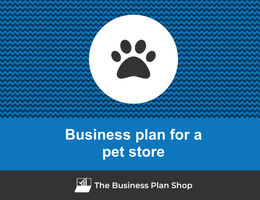How to create a financial forecast for a pet store?
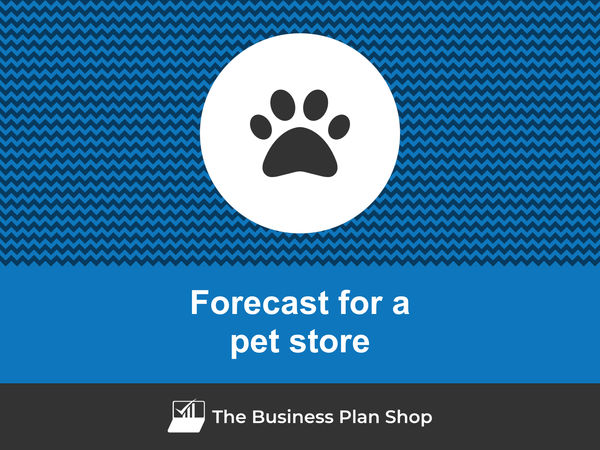
Creating a financial forecast for your pet store, and ensuring it stays up to date, is the only way to maintain visibility on future cash flows.
This might sound complex, but with the right guidance and tools, creating an accurate financial forecast for your pet store is not that hard.
In this guide, we'll cover everything from the main goal of a financial projection, the data you need as input, to the tables that compose it, and the tools that can help you build a forecast efficiently.
Without further ado, let us begin!
Why create and maintain a financial forecast for a pet store?
Creating and maintaining an up-to-date financial forecast is the only way to steer the development of your pet store and ensure that it can be financially viable in the years to come.
A financial plan for a pet store enables you to look at your business in detail - from income to operating costs and investments - to evaluate its expected profitability and future cash flows.
This gives you the visibility needed to plan future investments and expansion with confidence.
And, when your trading environment gets tougher, having an up to date pet store forecast enables you to detect potential upcoming financing shortfalls in advance, enabling you to make adjustments or secure financing before you run out of cash.
It’s also important to remember that your pet store's financial forecast will be essential when looking for financing. You can be 100% certain that banks and investors will ask to see your numbers, so make sure they’re set out accurately and attractively.
Need a solid financial forecast?
The Business Plan Shop does the maths for you. Simply enter your revenues, costs and investments. Click save and our online tool builds a three-way forecast for you instantly.

What information is needed to build a pet store financial forecast?
The quality of your inputs is key when it comes to financial modelling: no matter how good the model is, if your inputs are off, so will the forecast.
If you are building a financial plan to start a pet store, you will need to have done your market research and have a clear picture of your sales and marketing strategies so that you can project revenues with confidence.
You will also need to have a clear idea of what resources will be required to operate the pet store on a daily basis, and to have done your research with regard to the equipment needed to launch your venture (see further down this guide).
If you are creating a financial forecast of an existing pet store, things are usually simpler as you will be able to use your historical accounting data as a budgeting base, and complement that with your team’s view on what lies ahead for the years to come.
Let's now zoom in on what will go in your pet store's financial forecast.
The sales forecast for a pet store
From experience, it usually makes sense to start your pet store's financial projection with the revenues forecast.
The inputs used to forecast your sales will include the historical trading data of your pet store (which can be used as a starting point for existing businesses) and the data collected in your market research (which both new ventures and existing businesses need to project their sales forward).
Your pet store's sales forecast can be broken down into two key estimates:
- The average price
- The number of monthly transactions
To assess these variables accurately, you will need to consider the following factors:
- Pet ownership trends: As the popularity of certain types of pets fluctuates, so too may the demand and prices for related products. Stay updated on the latest pet ownership trends to anticipate changes in your business's average price and number of monthly transactions.
- Economic conditions: Economic downturns or recessions may result in reduced consumer spending, which could affect the average price and number of monthly transactions at your pet store. Keep an eye on the overall economic climate and adjust your forecast accordingly.
- Seasonal fluctuations: Many pet owners purchase seasonal items for their pets, such as costumes for Halloween or warm jackets for winter. These seasonal fluctuations in demand may affect your business's average price and number of monthly transactions. Plan ahead and stock up on popular seasonal items to maximize sales.
- Competition: The presence of other pet stores in your area may affect your business's average price and number of monthly transactions. Keep an eye on your competitors' prices and offerings to stay competitive and attract more customers.
- Product availability: The availability of certain products, such as popular pet food brands or specialty items, may affect the average price and number of monthly transactions at your pet store. Stay in touch with your suppliers and be prepared to make adjustments if certain products become unavailable.
Once you have a sales forecast in place, the next step will be to work on your overhead budget. Let’s have a look at that now.
Need inspiration for your business plan?
The Business Plan Shop has dozens of business plan templates that you can use to get a clear idea of what a complete business plan looks like.

The operating expenses for a pet store
The next step is to estimate the expenses needed to run your pet store on a day-to-day basis.
These will vary based on the level of sales expected, and the location and size of your business.
But your pet store's operating expenses should include the following items at a minimum:
- Staff Costs: You will need to budget for salaries, benefits, and any training or professional development for your employees. This can include store managers, sales associates, groomers, and other staff members.
- Accountancy Fees: As a business owner, you will need to hire an accountant to handle your taxes, bookkeeping, and financial statements. This will help ensure that your records are accurate and compliant with tax laws.
- Insurance Costs: It's important to protect your business and assets with insurance. This can include liability insurance, property insurance, and workers' compensation insurance for your employees.
- Software Licenses: To run your pet store efficiently, you may need to invest in software for inventory management, point of sale systems, and accounting software. These licenses will need to be renewed periodically.
- Banking Fees: You will need to open a business bank account and budget for any fees associated with maintaining the account, such as transaction fees, monthly maintenance fees, and wire transfer fees.
- Rent: If you do not own the building your pet store is located in, you will need to budget for rent payments. This can also include utilities such as electricity, water, and internet.
- Inventory Costs: As a pet store, you will need to purchase inventory to sell to your customers. This can include food, toys, accessories, and other pet products.
- Marketing and Advertising: To attract customers to your pet store, you will need to budget for marketing and advertising expenses. This can include print ads, online ads, and social media marketing.
- Professional Services: Depending on your business needs, you may need to hire additional professional services such as legal counsel, marketing consultants, or web designers.
- Maintenance and Repairs: It's important to keep your pet store in good condition for your customers and employees. This can include routine maintenance, repairs, and renovations.
- Pet Care Supplies: If you offer services such as grooming or pet daycare, you will need to budget for supplies such as shampoo, grooming tools, and cleaning products.
- Training and Education: To stay updated on the latest pet care trends and techniques, you may need to budget for training and education for yourself and your employees.
- Office Supplies: You will need basic office supplies such as paper, pens, and printer ink to keep your pet store running smoothly.
- Taxes and Licenses: As a business owner, you will need to pay taxes and obtain any necessary licenses to operate your pet store legally.
- Delivery and Shipping Costs: If you offer delivery or shipping services for your products, you will need to budget for any associated costs such as packaging materials and shipping fees.
This list is, of course, not exhaustive, and you'll have to adapt it according to your precise business model and size. A small pet store might not have the same level of expenditure as a larger one, for example.
What investments are needed to start or grow a pet store?
Your pet store financial forecast will also need to include the capital expenditures (aka investments in plain English) and initial working capital items required for the creation or development of your business.
For a pet store, these could include:
- Inventory: As a pet store owner, you will need to purchase inventory to stock your store with products such as pet food, toys, grooming supplies, and other pet-related items.
- Equipment: You may need to invest in various equipment for your pet store, such as cages, tanks, grooming tables, and other fixtures to provide a comfortable and safe environment for your pets.
- Furniture and Fixtures: In addition to equipment, you may also need to purchase furniture and fixtures for your store, including display shelves, counters, and seating areas for customers.
- Store Renovations: Depending on the condition of your store, you may need to allocate funds for renovations and improvements to create an inviting and functional space for both your pets and customers.
- Delivery Vehicle: If you offer delivery services for pet supplies, you may need to purchase a delivery vehicle to transport products to customers' homes and other locations.
Again, this list will need to be adjusted according to the size and ambitions of your pet store.
Need a convincing business plan?
The Business Plan Shop makes it easy to create a financial forecast to assess the potential profitability of your projects, and write a business plan that’ll wow investors.

The financing plan of your pet store
The next step in the creation of your financial forecast for your pet store is to think about how you might finance your business.
You will have to assess how much capital will come from shareholders (equity) and how much can be secured through banks.
Bank loans will have to be modelled so that you can separate the interest expenses from the repayments of principal, and include all this data in your forecast.
Issuing share capital and obtaining a bank loan are two of the most common ways that entrepreneurs finance their businesses.
What tables compose the financial plan for a pet store?
Now let's have a look at the main output tables of your pet store's financial forecast.
The forecasted profit & loss statement
The profit & loss forecast gives you a clear picture of your business’ expected growth over the first three to five years, and whether it’s likely to be profitable or not.
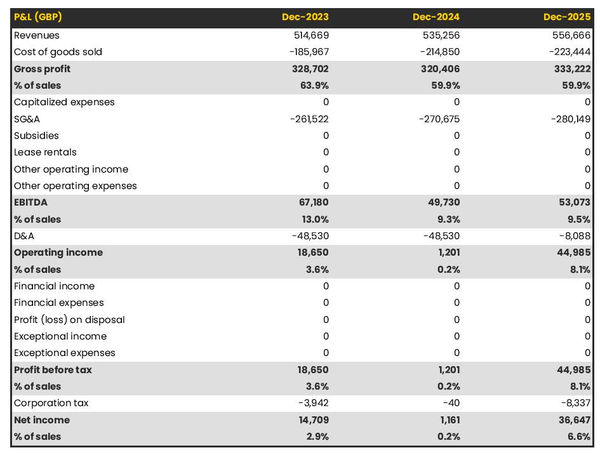
A healthy pet store's P&L statement should show:
- Sales growing at (minimum) or above (better) inflation
- Stable (minimum) or expanding (better) profit margins
- A healthy level of net profitability
This will of course depend on the stage of your business: numbers for an established pet store will look different than for a startup.
The projected balance sheet
Your pet store's forecasted balance sheet enables you to assess your financial structure and working capital requirements.
It is composed of three types of elements: assets, liabilities and equity:
- Assets: represent what the business owns and uses to produce cash flows. It includes resources such as cash, equipment, and accounts receivable (money owed by clients).
- Liabilities: represent funds advanced to the business by lenders and other creditors. It includes items such as accounts payable (money owed to suppliers), taxes due and loans.
- Equity: is the combination of what has been invested by the business owners and the cumulative profits and losses generated by the business to date (which are called retained earnings). Equity is a proxy for the value of the owner's stake in the business.
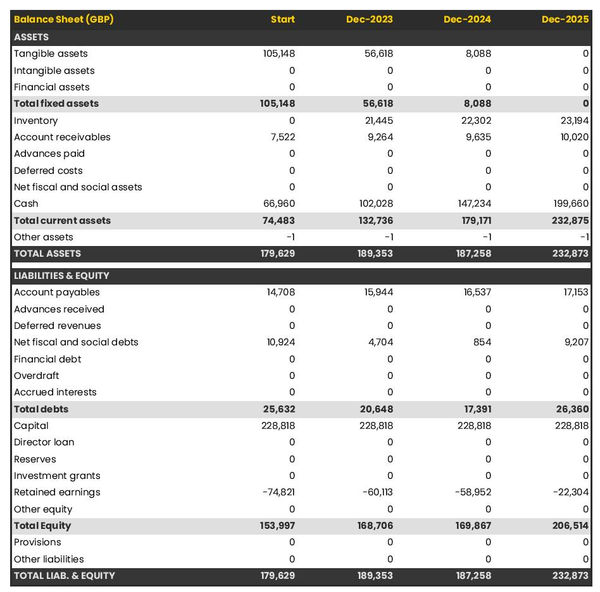
The cash flow projection
The cash flow forecast of your pet store will show how much cash the business is expected to generate or consume over the next three to five years.
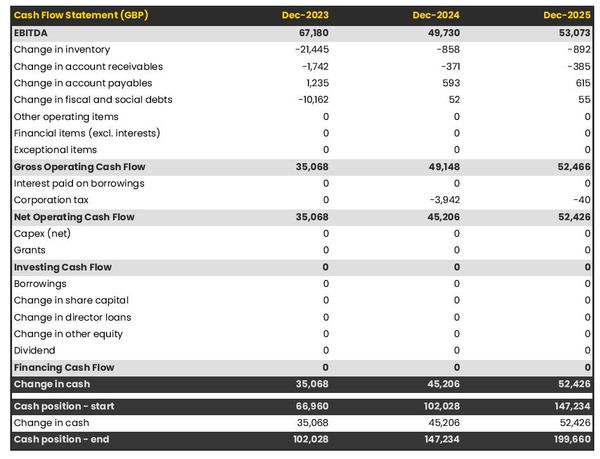
There are multiple ways of presenting a cash flow forecast but from experience, it is better to organise it by nature in order to clearly show these elements:
- Operating cash flow: how much cash is generated by the pet store's operations
- Investing cash flow: what is the business investing to expand or maintain its equipment
- Financing cash flow: is the business raising additional funds or repaying financiers (debt repayment, dividends)
Your cash flow forecast is the most important element of your overall financial projection and that’s where you should focus your attention to ensure that your pet store is adequately funded.
Note: if you are preparing a financial forecast in order to try to secure funding, you will need to include both a yearly and monthly cash flow forecast in your pet store's financial plan.
Need a solid financial forecast?
The Business Plan Shop does the maths for you. Simply enter your revenues, costs and investments. Click save and our online tool builds a three-way forecast for you instantly.

Which tool should you use to create your pet store's financial forecast?
Using the right tool or solution will make the creation of your pet store's financial forecast much easier than it sounds. Let’s explore the main options.
Using online financial forecasting software to build your pet store's projections
The modern and easiest way is to use professional online financial forecasting software such as the one we offer at The Business Plan Shop.
There are several advantages to using specialised software:
- You can easily create your financial forecast by letting the software take care of the financial calculations for you without errors
- You have access to complete financial forecast templates
- You get a complete financial forecast ready to be sent to your bank or investors
- You can easily track your actual financial performance against your financial forecast, and recalibrate your forecast as the year goes by
- You can create scenarios to stress test your forecast's main assumptions
- You can easily update your forecast as time goes by to maintain visibility on future cash flows
- You have a friendly support team on standby to assist you when you are stuck
- It’s cost-efficient and much cheaper than using an accountant or consultant (see below)
If you are interested in this type of solution, you can try our forecasting software for free by signing up here.
Calling in a financial consultant or chartered accountant
Enlisting the help of a consultant or accountant is also a good way to obtain a professional pet store financial forecast.
The downside of this solution is its cost. From experience, obtaining a simple financial forecast over three years (including a balance sheet, income statement, and cash flow statement) is likely to cost a minimum of £700 or $1,000.
The indicative cost above, is for a small business, and a forecast is done as a one-shot exercise. Using a consultant or accountant to track your actuals vs. forecast and to keep your financial projections up to date on a monthly or quarterly basis will cost a lot more.
If you opt for this solution, make sure your accountant has in-depth knowledge of your industry, so that they may challenge your figures and offer insights (as opposed to just taking your assumptions at face value to create the forecast).
Why not use a spreadsheet such as Excel or Google Sheets to build your pet store's financial forecast?
Creating an accurate and error-free pet store financial forecast on Excel (or any spreadsheet) is very technical and requires both a strong grasp of accounting principles and solid skills in financial modelling.
Most entrepreneurs lack the expertise required to create an accurate financial forecast using spreadsheet software like Excel or Google Sheets. As a result, it is unlikely anyone will trust your numbers.
The second reason is that it is inefficient. Building forecasts on spreadsheets was the only option in the 1990s and early 2000s, nowadays technology has advanced and software can do it much faster and much more accurately.
This is why professional forecasters all use software. With the rise of AI, software is also becoming smarter at helping us detect mistakes in our forecasts and helping us analyse the numbers to make better decisions.
Finally, like everything with spreadsheets, tracking actuals vs. forecasts and updating your forecast as the year progresses is manual, tedious, error-prone, and time-consuming. Whereas financial forecasting software like The Business Plan Shop is built for this.
Need a convincing business plan?
The Business Plan Shop makes it easy to create a financial forecast to assess the potential profitability of your projects, and write a business plan that’ll wow investors.

Use our financial projection templates for inspiration
The Business Plan Shop has dozens of financial forecasting templates available.
Our examples contain both the financial forecast, and a written business plan which presents, in detail, the company, the team, the strategy, and the medium-term objectives.
Whether you are just starting out or already have your own pet store, looking at our template is always a good way to get ideas on how to model financial items and what to write when creating a business plan to secure funding.
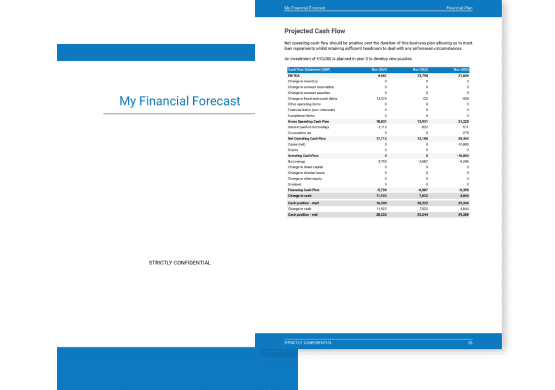
Takeaways
- A financial forecast shows expected growth, profitability, and cash generation metrics for your pet store.
- Tracking actuals vs. forecast and having an up-to-date financial forecast is key to maintaining visibility on your future cash flows.
- Using financial forecasting software is the modern way of creating and maintaining financial projections.
We hope that this guide helped you gain a clearer perspective on the steps needed to create the financial forecast for a pet store. Don't hesitate to contact us if you have any questions!
Need inspiration for your business plan?
The Business Plan Shop has dozens of business plan templates that you can use to get a clear idea of what a complete business plan looks like.

Also on The Business Plan Shop
Know someone who runs a pet store? Share our business guide with them!


